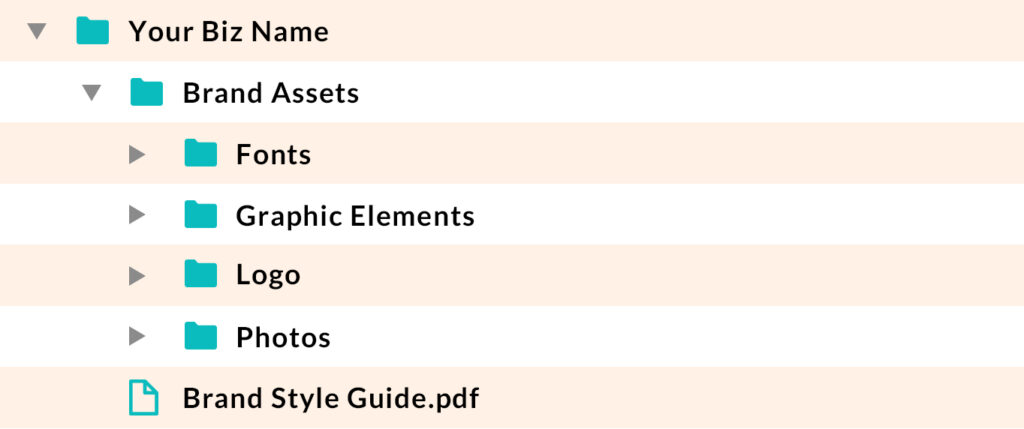O
ne of the things I love about Marie Kondo’s Konmari method is that it can be applied to pretty much anything. In this post, I’m going to share how you can use her organizing and tidying principles to get your brand into a place that’s streamlined, inspires you and your audience, and ‘sparks joy’.
The KonMari Principles (Brand Edition)
- Commit yourself to tidying up.
- Imagine your ideal lifestyle brand.
- Finish discarding first.
- Tidy by category, not by location.
- Follow the right order.
- Ask yourself if it sparks joy.
Start With Gratitude
In each episode of ‘Tidying Up’, Marie Kondo starts by thanking the home she’s about to work in. I love this idea of gratitude because I think that taking a moment to appreciate what something’s done for you makes it much easier to let things go when they no longer work for you.
One thing I’ve found myself doing is saying, “Thank you for what you’ve done, but someone else gets to enjoy you now.” Or, “thank you for your service to me, but you are no longer serving me.”
1. Commit Yourself to Tidying Up
To make this project manageable, I would suggest focusing only on your core brand elements, such as color palette, fonts, brand photos, graphics, etc. I would recommend tackling any promotional or marketing materials as a separate project. That would include any templates you use, your business cards, brochures, etc.
2. Imagine Your Ideal Brand
Okay, this is very important–visualize the end result. Where to you want your brand to go? What do you want it to represent? Imagine that ideal state.
- Put together a vision board of your brand’s ideal look and feel. If you already have one, open it up and see if it still holds true to your vision.
- Make a list of the feelings you want your brand to embody. What are your brand’s personality traits?
- Describe your target audience.
3. Finish Discarding First
Keep your vision board, list of brand traits, and target audience description close. Then collect all your brand elements in one place, whether it be in a document on your computer or printed out and spread across your living room floor.
Questions to Ask
- What’s working? Which items feel representative of both your target audience and your business?
- What do you still like but needs to be tweaked to better fit your ideal brand?
- What’s not working? Thank it for its service to you and toss it out.
Steps to Take
- Limit your font palette to 3 or less. This is especially important in keeping your website speedy. More fonts equal longer page load times.
- Compile all the colors you’re using across your materials. Group them into main brand colors and secondary brand colors. Eliminate any strays to keep your visual brand cohesive. Are you consistently using the same hex code for each color? If not, make sure to decide on one, document it, and refer back to it later.
- Are your graphics cohesive in style?
- Do photos you use align with your ideal brand look and feel? Do they connect with your target audience?
Important note: You may really like a brand element you’re using, but it may not resonate with your target audience. It’s important to make sure that whatever you keep serves both purposes.
Also, intention is key here. Be thoughtful about which items to keep or discard, and really ask yourself if they stand up to the ideal brand you want to create.
4. Organize by Category
In this step, I want you to organize your files so you can easily find things later.
-
- Create a brand style guide to refer back to later. What’s a brand style guide? It’s a collection of guidelines that helps establish your brand’s look and feel. In my style guides I like to include the logo, any submarks, graphic elements, color palette, fonts, and samples of photography that show a particular style.
- Create a folder structure that looks like the following and add your files.

5. Follow the Right Order
I don’t think you need to go in a specific order with the brand elements, but I do believe you need to first define a vision and your target audience before you get started. Use that to guide you. Measure your decisions against that vision.
6. Ask Yourself If It Sparks Joy
If it doesn’t spark joy for you, thank it for its service to you, and toss it out! If you’re not excited about your brand, your audience won’t be either.
What’s Next?
Remember that ideal brand you visualized earlier? Make a list of anything you might now need to create to get there. Then, create those things. After that, tackle your brand promotional items like business cards, brochures, etc.
Share Your Thoughts
Does your brand ‘spark joy’?







